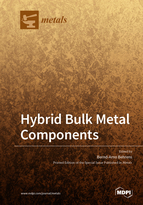Hybrid Bulk Metal Components
A special issue of Metals (ISSN 2075-4701).
Deadline for manuscript submissions: closed (31 December 2020) | Viewed by 29124
Special Issue Editor
Interests: sheet metal forming; bulk metal forming; forming machines; material characterization and simulation; tailored forming
Special Issues, Collections and Topics in MDPI journals
Special Issue Information
Dear Colleagues,
In recent years, the requirements for technical components have steadily been increasing. This development is intensified by the desire for products with a lower weight, smaller size, and extended functionality, but also with a higher resistance against specific stresses.
Mono-material components, which are produced by established processes, feature limited properties according to their respective material characteristics. Thus, a significant increase in production quality and efficiency can only be reached by combining different materials in a hybrid metal component. In this way, components with tailored properties can be manufactured that meet the locally varying requirements. Through the local use of different materials within a component, for example, the weight or the use of expensive alloying elements can be reduced.
The aim of this Special Issue is to cover the recent progress and new developments regarding all aspects of hybrid bulk metal components. This includes fundamental questions regarding the joining, forming, finishing, simulation, and testing of hybrid metal parts.
Prof. Dr. Bernd-Arno Behrens
Guest Editor
Manuscript Submission Information
Manuscripts should be submitted online at www.mdpi.com by registering and logging in to this website. Once you are registered, click here to go to the submission form. Manuscripts can be submitted until the deadline. All submissions that pass pre-check are peer-reviewed. Accepted papers will be published continuously in the journal (as soon as accepted) and will be listed together on the special issue website. Research articles, review articles as well as short communications are invited. For planned papers, a title and short abstract (about 100 words) can be sent to the Editorial Office for announcement on this website.
Submitted manuscripts should not have been published previously, nor be under consideration for publication elsewhere (except conference proceedings papers). All manuscripts are thoroughly refereed through a single-blind peer-review process. A guide for authors and other relevant information for submission of manuscripts is available on the Instructions for Authors page. Metals is an international peer-reviewed open access monthly journal published by MDPI.
Please visit the Instructions for Authors page before submitting a manuscript. The Article Processing Charge (APC) for publication in this open access journal is 2600 CHF (Swiss Francs). Submitted papers should be well formatted and use good English. Authors may use MDPI's English editing service prior to publication or during author revisions.
Keywords
- Lightweight design
- Tailored properties
- Bulk metal forming
- Hybrid metal components
- Welding
- Joining zone
- Mechanical behaviour
- Modelling and simulation
- Microstructure






